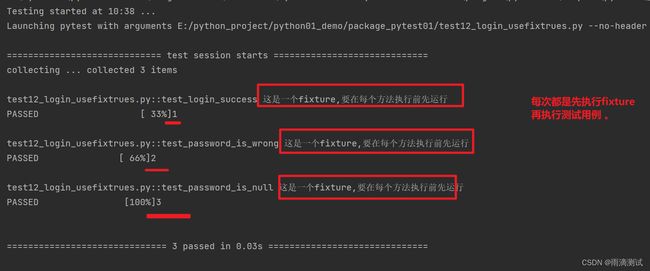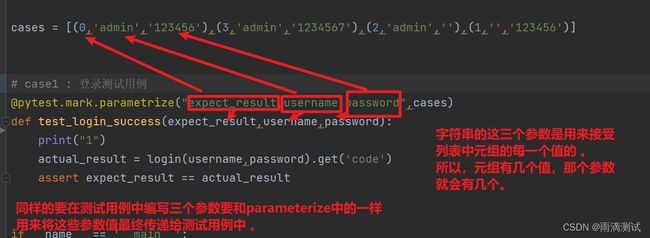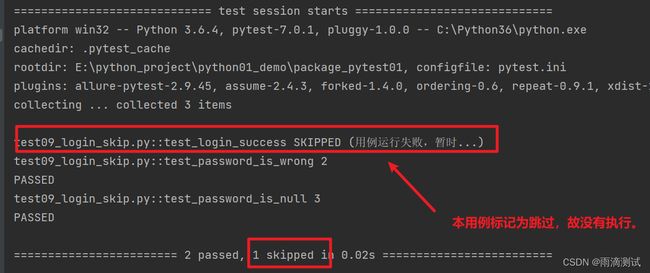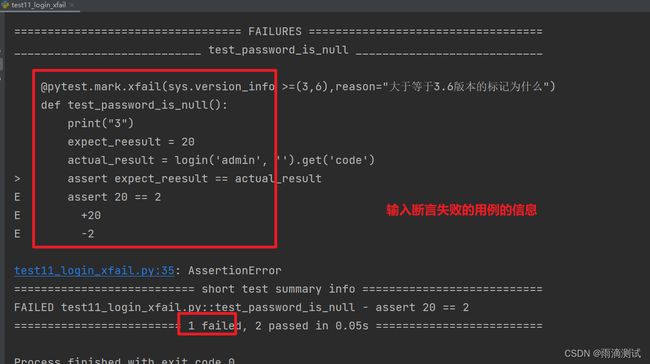自动化测试框架pytest系列之8个常用的装饰器函数
自动化测试框架pytest系列之基础概念介绍(一)-CSDN博客
自动化测试框架pytest系列之21个命令行参数介绍(二)-CSDN博客
自动化测试框架pytest系列之强大的fixture功能,为什么fixture强大?一文拆解它的功能参数。(三)-CSDN博客
接上文
3.5 pytest的8个装饰器
在之前的文章可以看到,fixture本身就是以装饰器的形式去使用的。但在pytest中,其实有很多的装饰器函数,接下来我们就捋一下有哪些装饰器 。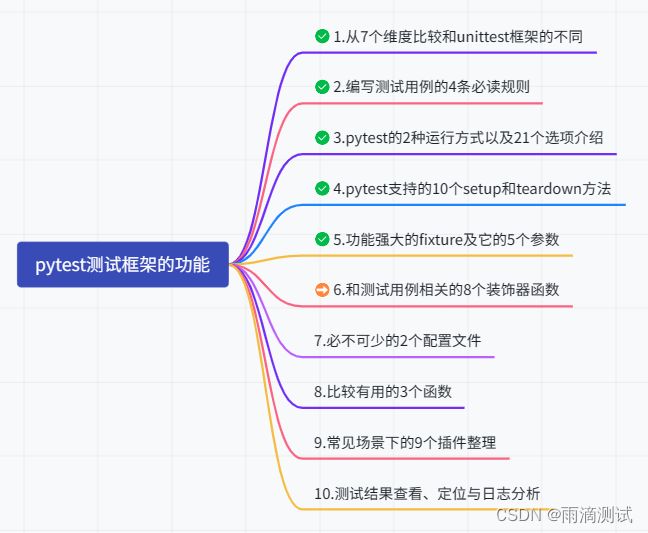
如果你自己发现 ,除了fixture本身 ,其他的都在mark后面进行标记 。所以这个mark非常重要 。
此功能应该是pytest中最核心和强大的功能 ,为了介绍此功能 ,本人足足写了1.8w字 。具体可查看链接 :自动化测试框架pytest到底都有哪些实用功能 ?pytest系列文章之fixture的介绍(一)。 - 知乎 (zhihu.com)
-
功能 :可以在测试用例中引入fixture的功能 ,
-
格式 :@pytest.mark.usefixtures("fixture函数名"),其中参数必须传递fixture的函数名字 ,而且要用引号引起来 。
-
区别 :和fixture()传递给测试用例的区别是 :
-
fixture:既可以将返回值传给测试用例,也可以无任何返回值,比如像上面的打印语句,本身不返回任何信息。
-
usefixture :无法将返回值的函数传递给测试用例 ,即测试用例只能接受无返回值的usefixture 。
-
-
需求 :给登录的每条测试用例中添加一个打印信息,具体如下:
import pytest
from package_pytest.login import login
# fixture
@pytest.fixture()
def demo_fixture():
print("这是一个fixture,要在每个方法执行前先运行")
# case1 : 输入正确的用户名和正确的密码进行登录
@pytest.mark.usefixtures('demo_fixture')
def test_login_success():
print("1")
expect_result = 0
actual_result = login('admin','123456').get('code')
assert expect_result == actual_result
# case2 : 输入正确的用户名和错误的密码进行登录
@pytest.mark.usefixtures('demo_fixture')
def test_password_is_wrong():
print("2")
expect_reesult = 3
actual_result = login('admin','1234567').get('code')
assert expect_reesult == actual_result
# case3 : 输入用户名和空的密码进行登录
@pytest.mark.usefixtures('demo_fixture')
def test_password_is_null():
print("3")
expect_reesult = 2
actual_result = login('admin', '').get('code')
assert expect_reesult == actual_result
if __name__ == '__main__':
pytest.main(['test12_login_usefixtrues.py','-sv'])-
说明 :
-
定义了一个demo_fixture函数 ,其中这个函数想被测试用例调用 。
-
在调用的测试用例前加上@pytest.mark.usefixtures('demo_fixture') ,相当于把fixture函数传递给了测试用例了 。
-
所以 ,在测试用例运行就会先执行fixture函数内的代码了 。
-
-
功能 :可以专门为某条测试用例进行参数化 ,
-
格式 :@pytest.mark.parametrize(参数,列表) ,其中参数主要为了传递给测试用例使用的,它接受的是字符串类型 。而列表是用来接收测试数据的。
-
需求 :要将登录的4条测试数据传入给登录测试用来,该如何做 ,使用parametrize代码实现为 :
import pytest
from package_pytest.login import login
cases = [(0,'admin','123456'),(3,'admin','1234567'),(2,'admin',''),(1,'','123456')]
# case: 登录测试用例
@pytest.mark.parametrize("expect_result,username,password",cases)
def test_login_success(expect_result,username,password):
print("1")
actual_result = login(username,password).get('code')
assert expect_result == actual_result-
功能 :可以做回归测试或者打包测试套件
-
格式 :@pytest.mark.标识符 ,其中标识符可以是任何字符。
-
说明:在测试用例中,我们经常通过用例级别代表用例的重要程度 ,比如会把用例设置为p1 , p2 ,p3 ,p4 .而在pytest中就可以mark进行标记 。
-
需求 :对登录成功的用例标记为p1 ,对登录失败的用例标记为p2 ,具体代码如下 :
# case1 : 输入正确的用户名和正确的密码进行登录
@pytest.mark.p1
def test_login_success():
print("1")
expect_result = 0
actual_result = login('admin','123456').get('code')
assert expect_result == actual_result
# case2 : 输入正确的用户名和错误的密码进行登录
@pytest.mark.p2
def test_password_is_wrong():
print("2")
expect_reesult = 3
actual_result = login('admin','1234567').get('code')
assert expect_reesult == actual_result
# case3 : 输入用户名和空的密码进行登录
@pytest.mark.p2
def test_password_is_null():
print("3")
expect_reesult = 2
actual_result = login('admin', '').get('code')
assert expect_reesult == actual_result
if __name__ == '__main__':
pytest.main(['test08_login_mark.py','-sv','-m','p1'])可以看到 ,我们在main函数中传入了-m和p1 ,就代表只运行mark中标记为p1级别的用例 ,这样就实现了部分用例的执行。
运行结果如下 :
-
功能 :用例跳过,比如某条用例暂时失败了,但是找不到原因 ,可以先标记为跳过 。
-
格式 :@pytest.mark.skip(reason) ,这里的reason就是跳过的原因
-
需求 :对登录成功的用例标记为跳过,在执行的时候不运行 ,具体代码如下 :
import pytest
from package_pytest.login import login
# case1 : 输入正确的用户名和正确的密码进行登录
@pytest.mark.skip(reason="用例运行失败,暂时找不到失败原因,跳过该用例执行。")
def test_login_success():
print("1")
expect_result = 0
actual_result = login('admin','123456').get('code')
assert expect_result == actual_result
# case2 : 输入正确的用户名和错误的密码进行登录
@pytest.mark.p2
def test_password_is_wrong():
print("2")
expect_reesult = 3
actual_result = login('admin','1234567').get('code')
assert expect_reesult == actual_result
# case3 : 输入用户名和空的密码进行登录
@pytest.mark.p2
def test_password_is_null():
print("3")
expect_reesult = 2
actual_result = login('admin', '').get('code')
assert expect_reesult == actual_result
if __name__ == '__main__':
pytest.main(['test09_login_skip.py','-sv'])-
功能 :选择性跳过用例,条件为True才会跳过 。
-
格式 :@pytest.mark.skipif(表达式) ,这里只能做一些简单的判断。
-
说明 :和skip相比 ,只要标记为skip,此用例就会跳过,而标记为skipif的话,这里有个判断,只有为ture的情况下才会跳过 。
-
需求 :对登录成功的用例标记选择性跳过,符合条件的将跳过该用例 ,具体代码如下 :
import pytest
from package_pytest.login import login
import sys
# case1 : 输入正确的用户名和正确的密码进行登录
@pytest.mark.skipif(sys.platform == "win32",reason="是windows平台的跳过")
def test_login_success():
print("1")
expect_result = 0
actual_result = login('admin','123456').get('code')
assert expect_result == actual_result
# case2 : 输入正确的用户名和错误的密码进行登录
@pytest.mark.skipif(sys.version_info <(3,6),reason="低于3.6版本的跳过")
def test_password_is_wrong():
print("2")
expect_reesult = 3
actual_result = login('admin','1234567').get('code')
assert expect_reesult == actual_result
# case3 : 输入用户名和空的密码进行登录
@pytest.mark.skipif(sys.version_info >=(3,6),reason="大于等于3.6版本的跳过")
def test_password_is_null():
print("3")
expect_reesult = 2
actual_result = login('admin', '').get('code')
assert expect_reesult == actual_result
if __name__ == '__main__':
pytest.main(['test10_login_skipif.py','-sv'])因为我的Python版本是3.6.4 ,故第二条用例不会被跳过,运行结果如下 : 
-
功能 :标记为失败用例,表示期望这个用例执行失败。
-
格式 :@pytest.mark.xfail(表达式,reason) ,表达式为True,标记为失败用例。
-
说明 :和skipif相比,skipif表达式为真,跳过用例执行,而标记xfail的话,表达式为真,则标记为失败 。
-
需求 :对登录用例中符合条件的都标记为失败用例 ,具体代码如下 :
import pytest
from package_pytest.login import login
import sys
# case1 : 输入正确的用户名和正确的密码进行登录
@pytest.mark.xfail(sys.platform == "win32",reason="是windows平台的跳过")
def test_login_success():
print("1")
expect_result = 0
actual_result = login('admin','123456').get('code')
assert expect_result == actual_result
# case2 : 输入正确的用户名和错误的密码进行登录
@pytest.mark.xfail(sys.version_info <(3,6),reason="低于3.6版本的标记为失败")
def test_password_is_wrong():
print("2")
expect_reesult = 3
actual_result = login('admin','1234567').get('code')
assert expect_reesult == actual_result
# case3 : 输入用户名和空的密码进行登录
@pytest.mark.xfail(sys.version_info >=(3,6),reason="大于等于3.6版本的标记为什么")
def test_password_is_null():
print("3")
expect_reesult = 20
actual_result = login('admin', '').get('code')
assert expect_reesult == actual_result
if __name__ == '__main__':
pytest.main(['test11_login_xfail.py','-sv'])以上是正常的运行结果 ,如果你只想运行失败的用例,你可以加入该选项'--runxfail' .
if __name__ == '__main__':
pytest.main(['test11_login_xfail.py','-sv','--runxfail'])-
功能 :控制用例的运行顺序 ,但它需要下载插件pytest-ordering .
-
格式 :@pytest.mark.run(order=n) ,其中n代表一个数字 ,数字越小,代表执行顺序越靠前 ,反之数字越大,越靠后。

